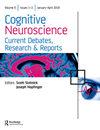如何建立更好的 4E 认知。
IF 2.2
4区 医学
Q3 NEUROSCIENCES
Cognitive Neuroscience
Pub Date : 2024-07-01
Epub Date: 2024-09-21
DOI:10.1080/17588928.2024.2403340
引用次数: 0
摘要
Mougenot 和 Matheson 概述了认知神经科学的理论方法,该方法将具身认知的承诺与科学解释的机械论方法相结合。他们认为,这种理论方法有几个普遍的好处,包括使研究人员能够发展出更强大的理论和本体论,而这些理论和本体论既不需要神经科学还原论,也不需要心理学从神经科学中完全独立出来。在这篇评论中,我认为他们所设想的这种具身认知神经科学有一个更具体的好处:它有可能帮助解决 4E 认知中的内部矛盾。本文章由计算机程序翻译,如有差异,请以英文原文为准。
How to build a better 4E cognition.
Mougenot and Matheson outline a theoretical approach to cognitive neuroscience that combines the commitments of embodied cognition with a mechanistic approach to scientific explanation. They argue that this theoretical approach provides several general benefits, including enabling researchers to develop more robust theories and ontologies that do not require either neuroscientific reductionism or the complete autonomy of psychology from neuroscience. In this commentary, I argue that the sort of embodied cognitive neuroscience that they envision has a more specific benefit: it has the potential to help resolve internal tensions within 4E cognition.
求助全文
通过发布文献求助,成功后即可免费获取论文全文。
去求助
来源期刊

Cognitive Neuroscience
NEUROSCIENCES-
CiteScore
3.60
自引率
0.00%
发文量
27
审稿时长
>12 weeks
期刊介绍:
Cognitive Neuroscience publishes high quality discussion papers and empirical papers on any topic in the field of cognitive neuroscience including perception, attention, memory, language, action, social cognition, and executive function. The journal covers findings based on a variety of techniques such as fMRI, ERPs, MEG, TMS, and focal lesion studies. Contributions that employ or discuss multiple techniques to shed light on the spatial-temporal brain mechanisms underlying a cognitive process are encouraged.
 求助内容:
求助内容: 应助结果提醒方式:
应助结果提醒方式:


